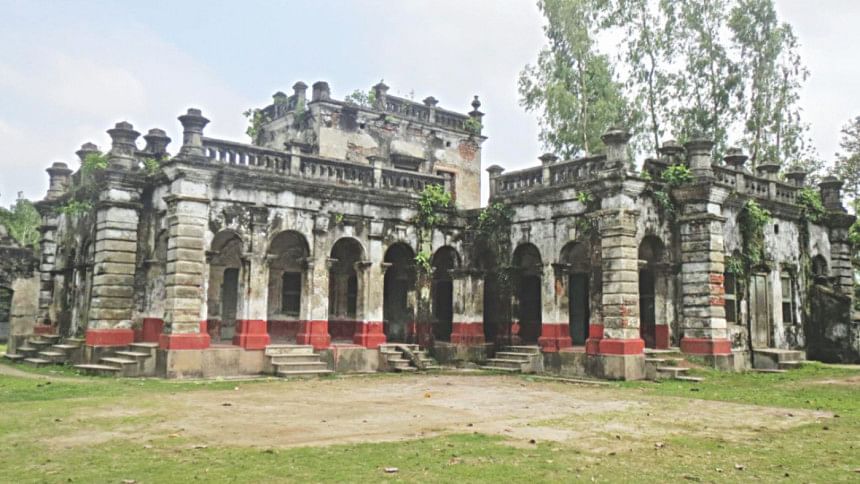Ulipur's historic Munshibari in desperate need of maintenance

Founded during the reign of Nawab Sirajuddaula, the attractive administrator's house, the Munshibari in Dharnibari union of Kurigram's Ulipur upazila is a draw card for anyone wishing to explore the area's rich historical heritage. But due to a lack of maintenance the future of the 250-year-old iconic building is uncertain.
The property, which features domed architecture and includes a playhouse, barnyard, Durga and Biswanu temples along with a dining room and kitchen, all of which are extensively damaged, has a colourful history.
It was established by Bonwari Munshi, a surveyor employed by the nawab who first arrived in the area on a hunting expedition along the now dry Bamnee River. Bonwari liked the lay of the land, it is said, and legend has it he was impressed to see a frog eating a snake there. Upon his return to the nawab Bonwari successfully requested a land allocation for himself.
Bonwari was childless so inheritance first passed to his adopted son Binod Lal who served under Laxmi Narayan. Binod too was childless; the munshibari passed for a second time to an adopted son, Brojendra Lal, who had two daughters. When the elder daughter was married and moved to Kolkata, with the younger daughter having died at a young age, Brojendra's wife Asharatha Munshi followed tradition and adopted a son Bihari Lal Munshi to take responsibility for the munshibari.
After the Liberation War in 1971, Bihari Lal also moved to Kolkata, and the property came under the care of, at first, an NGO activist, Saifur Mia and later, one Arif Mia. Arif Mia's claim to the property caused controversy. There was a heated dispute that infamously ended when Arif Mia drew his gun and fired, killing two local students.
It was in 1987 that the union revenue office took over the main building, where it is still housed.
“Our Munshibari is an historical asset for the whole Kurigram district,” says local Lutfar
Rahman, 65. “People from many places visit this site. It should be restored and maintained for future generations.”
“Two original flowering trees, a shada chapa and a gandhoraj tree are still here,” says Panko Chandra Mohanto, 72, the Munshibari temple priest. “But many of the structures are either damaged or going to be damaged. The metal stairs leading to the second floor and the metal veranda railings have already been stolen. I have spoken with the Dharnibari union council chairman and Ulipur's upazila nirbahi officer about the importance of protecting the property, but no maintenance has been undertaken.”
“The Munshibari is an historical site in the district and it needs preservation,” comments Ulipur's upzila nirbahi officer Shafiqul Islam. “We will try to ensure none of its structures deteriorate further.” He says he hopes some preservation work can be embarked upon this year under the auspices of initiatives such as the Food for Work programme.
Such restoration work cannot start a moment too soon: moss has colonised several parts of the building and the ceilings leak when it rains. Yet the Munshibari remains important to the area's community life. The Gobinda temple is active daily, the pond is used by locals and during Durga Puja a fair is traditionally held on the munshibari's grounds.

 For all latest news, follow The Daily Star's Google News channel.
For all latest news, follow The Daily Star's Google News channel. 



Comments